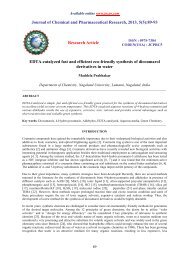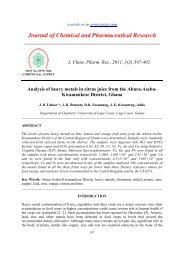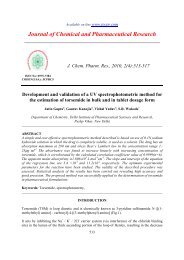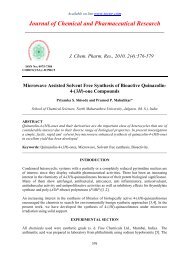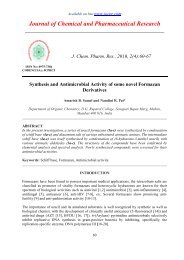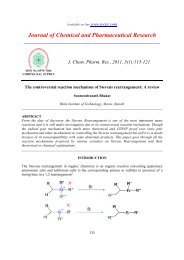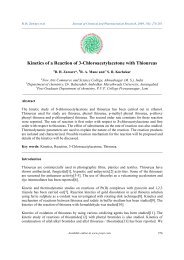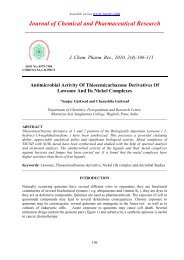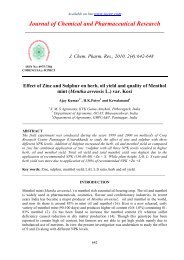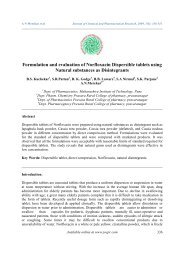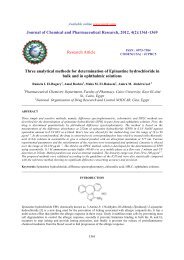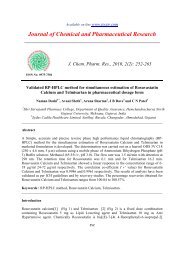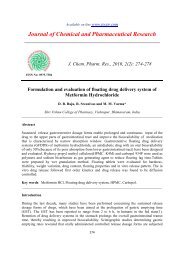An attitude error correction method based on MARG ... - Jocpr.com
An attitude error correction method based on MARG ... - Jocpr.com
An attitude error correction method based on MARG ... - Jocpr.com
You also want an ePaper? Increase the reach of your titles
YUMPU automatically turns print PDFs into web optimized ePapers that Google loves.
Mingjian Li et al J. Chem. Pharm. Res., 2013, 5(9):522-528______________________________________________________________________________bbwherenq , trepresents quaterni<strong>on</strong> solved using angular rate andnq , trepresents quaterni<strong>on</strong> solved using steepestdescent <str<strong>on</strong>g>method</str<strong>on</strong>g>. are weights which satisfy the following equati<strong>on</strong>. and (1 )t tt(1 t) tt(10)Assume is large, (9) be<strong>com</strong>esq qˆ q t(11)b b bn est , t n est , t1 n est , tˆbby substituting (8) to (10).nqest , t 1is the rotati<strong>on</strong> quaterni<strong>on</strong> at time 1qˆchange for rotati<strong>on</strong> quaterni<strong>on</strong>, andn , tbf ft , b b bˆnqest, tnqw, t nq , tis the rate ofis the <str<strong>on</strong>g>error</str<strong>on</strong>g> caused by measurement noise. Proporti<strong>on</strong>al gain and integral gain can be calculated using (12) and (13) with indicating the zero drift of gyroscope,indicating the drift rate , and ˆq being an arbitrary quaterni<strong>on</strong>.1 3 qˆ 0 2 (12)41 3 qˆ [0 ] (13)2 4RESULTSSIMULATION AND RESULTTo evaluate the performance of our proposed <strong>MARG</strong> algorithm, we carried out four simulati<strong>on</strong> experiments. EKFalgorithm is used for <strong>com</strong>paris<strong>on</strong>. We design a track generator following the procedure as described in [12] and adda triaxial magnetometer emulator.The variance of random noise of the gyroscope is set to 10 /h . The variance of the first-order Markov processnoise is set to 4 /h with time durati<strong>on</strong> of 1h. The variance of the first-order Markov process noise is set to 10 -4 gwith time durati<strong>on</strong> of 2h for the accelerometer. The variance of the first-order Markov process noise is 100nt withtime durati<strong>on</strong> of 1h. The sampling rate of the <strong>MARG</strong> sensor array is 100Hz.Picard angle increment <str<strong>on</strong>g>method</str<strong>on</strong>g> is used to obtain the quaterni<strong>on</strong> for the track generator. The calculated <str<strong>on</strong>g>attitude</str<strong>on</strong>g> angleis the same as the ground truth.Fig. 2 shows a <strong>com</strong>paris<strong>on</strong> between the calculated <str<strong>on</strong>g>attitude</str<strong>on</strong>g> angle using <strong>MARG</strong> algorithm with additi<strong>on</strong>al noise andthe ground truth. From the figure, we can see that the calculated value begins to deviate the true value after 20s withadditi<strong>on</strong>al noise added to the simulati<strong>on</strong>. With the simulati<strong>on</strong> time progresses, the <str<strong>on</strong>g>error</str<strong>on</strong>g> increases. The average <str<strong>on</strong>g>error</str<strong>on</strong>g>is over 10°. We can c<strong>on</strong>clude from the experiment that noise has a significant influence <strong>on</strong> the results. However,<strong>MARG</strong> sensors inevitably subject to measurement noise and envir<strong>on</strong>ment noise in real applicati<strong>on</strong>. Therefore,measurement data filtering is necessary before calculating the <str<strong>on</strong>g>attitude</str<strong>on</strong>g>.The <str<strong>on</strong>g>attitude</str<strong>on</strong>g> angle calculated using EKF is shown in Fig. 3. We can see that the calculated value is quite unstabledue to the random initial state and the filtering covariance matrix. After 40s of the simulati<strong>on</strong>, the calculated value isable to track the true value. The average <str<strong>on</strong>g>error</str<strong>on</strong>g> is approximately 0.1°.Fig. 4 displays a <strong>com</strong>paris<strong>on</strong> between the <str<strong>on</strong>g>attitude</str<strong>on</strong>g> angle calculated from <strong>MARG</strong> algorithm and the true angle. Formthe figure, we can observe that the calculated value is able to track the true value after 10s in simulati<strong>on</strong>. Theaverage <str<strong>on</strong>g>error</str<strong>on</strong>g> is about 0.15°. Both EKF and <strong>MARG</strong> algorithms have good c<strong>on</strong>vergence rate. Although <strong>MARG</strong>algorithm achieves similar accuracy as EKF algorithm, <strong>MARG</strong> algorithm c<strong>on</strong>verges much faster than EKF. It takes525



